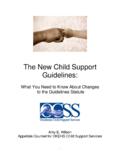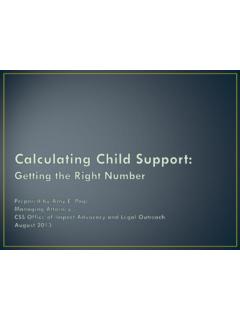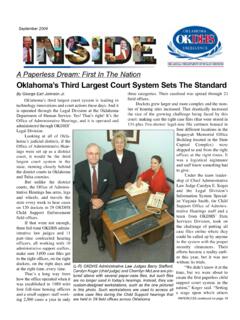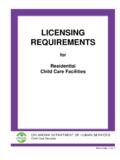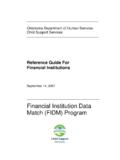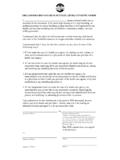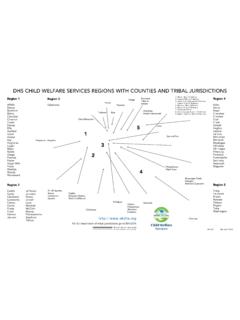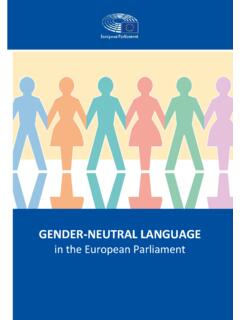Transcription of EARLY LEARNING GUIDELINES FOR CHILDREN
1 Oklahoma EARLY LEARNING . GUIDELINES FOR. CHILDREN . Ages Three through Five Table of Contents _____. INTRODUCTION 1. C ON CEPT AREAS. 1 _____. APP ROAC H E S TO LE ARNI N G 5. 2 _____. CRE AT I V E SKI LL S 10. 3 _____. L AN GUAGE ARTS 15. 4 _____. MAT H E M AT I C S 30. 5 _____. HEALT H , SAF E T Y 42. AND P H YSI C AL DE V E LOP M E NT. 6 _____. SCIE N C E 51. 7 _____. SOC I AL AND P E RSON AL SKI LL S 59. 8 _____. SOC I AL S T UDI E S 65. _____. GLOSSARY 72. _____. RESOURCES 74. _____. FEEDBAC K FORM 76. Oklahoma EARLY LEARNING GUIDELINES INTRODUCTION. The EARLY LEARNING GUIDELINES are intended to provide guidance to teachers with regard to what CHILDREN should know and be able to do in order to experience school success.
2 Stars The EARLY LEARNING GUIDELINES provide examples of activities that can be used to develop curriculum. They should not be used as a curriculum or assessment. Program providers that Oklahoma are trained in EARLY childhood curriculum theories will EARLY LEARNING GUIDELINES provide an enriched curriculum including the following activities and many others. The GUIDELINES are intended A Task Force convened by the Oklahoma Department of to assist with LEARNING activities for preschool CHILDREN ages Human Services Oklahoma Child Care Services 3 through 5 and are inclusive of all CHILDREN recognizing that developed the Oklahoma EARLY LEARNING GUIDELINES .
3 CHILDREN may be able to show they meet the Standards at Task force members included representatives from the Oklahoma State Department of Education, Oklahoma different times and in different ways. Tribal Child Care Association, Oklahoma Head Start Association, and child care programs. The GUIDELINES Guiding Principles: reflect current research on growth and stages of All CHILDREN are active learners. They explore and development, appropriate program planning, LEARNING outcomes for CHILDREN , and best practices in EARLY experiment with concepts in the world through play education. The GUIDELINES are designed to align with the and hands on activities.
4 Oklahoma Priority Academic Student Skills (PASS) Through interaction with friends, family and other and Head Start Performance Standards and to promote adults, CHILDREN develop new skills and understandings EARLY LEARNING experiences that lead to CHILDREN 's success. The word teacher is used in the GUIDELINES to represent of concepts. CHILDREN need opportunities to practice parents, family members, educators, caregivers, and new skills as well as experience challenges. caring adults who offer instruction, support, and Families are the child's first and most important teachers. guidance to young CHILDREN . CHILDREN are influenced by the values of their family, culture, and community.
5 Developing in generally similar stages, CHILDREN show individual differences in ways of knowing, LEARNING , and doing. Overview EARLY childhood programs should be appropriate for the age, developmental level, and special needs of each child. The environment should be modified and adapted to promote the participation, engagement, and LEARNING of all CHILDREN . Young CHILDREN are integrally connected to their families and it is important to establish positive relationships with family members that are based on mutual trust and respect. Teaching is based on the knowledge of content and how young CHILDREN develop and learn. The LEARNING environment fosters all areas of development: creative/aesthetic, intellectual, language, physical and social/emotional; and provides the challenge for CHILDREN to learn according to their individual growth patterns.
6 1. EARLY childhood programs should: Families Can Use GUIDELINES to: Provide curriculum that builds upon what CHILDREN already Broaden understanding of ways CHILDREN know and are able to do to enable them to connect new are developing and LEARNING . concepts and skills. Determine ways to support CHILDREN ' s development Provide units or themes of interest that integrate and teach and LEARNING at home. across all areas of the core curriculum ( , foreign Discuss how to partner with others to provide languages, language arts including reading, mathematics, for continuity of LEARNING . science, social studies, the arts). Identify what is important to look for when Provide a literacy rich environment arranged in LEARNING choosing programs for CHILDREN .
7 Centers or LEARNING areas ( , art center, science center, reading center, dramatic play center, block center). Each Inclusion center will have a variety of activities for the CHILDREN . This Young CHILDREN come to programs with varying arrangement allows for a wide range of developmental experiences, backgrounds and language. Recognizing that interests and abilities within the same LEARNING space. CHILDREN learn at different rates and have varying abilities, Provide exposure to a wide variety of information and the curriculum and environment should be adapted so that literacy experiences and the use of technology through all CHILDREN can reach their potential.
8 Adults should consider daily activities in the environment and/or media center. the following when planning activities: Provide a safe environment designed for the Consulting CHILDREN 's family members and others in the developmental needs of the age group served and community who have expertise in the languages and implemented with attention to the requirements and cultures of the CHILDREN attending learn simple words differences of the individual CHILDREN . for foods in other languages and encourage CHILDREN to Provide a climate that is active; one in which CHILDREN bring pictures of family, favorite foods for snack, materials interact with each other and materials while engaging that are familiar for dramatic play, or music in cooperative hands on LEARNING with day to day Conveying respect for English Language Learners (ELL).
9 Life experiences. and their home language, speaking clearly, using Provide a balance of activities that are adult directed and simple words and short phrases and repetition when child initiated. These activities may be active or quiet, speaking to CHILDREN , paraphrasing and modeling correct performed individually or in large and small groups. use of English instead of correcting CHILDREN 's language Provide an environment that is sensitive to cultural, and allowing CHILDREN to be silent as they are in the language, physical, and LEARNING differences among all process of LEARNING English. CHILDREN served. Accommodate CHILDREN by using special Creative means of communicating ideas gestures, or adaptive devices or adjustments to activities to improve pictures, and real objects can be used to help communicate communication and/or participation in activities.
10 With CHILDREN and CHILDREN can express themselves through Provide an on going process of collecting information drawing, painting, using clay, and movement activities. from multiple sources about a child's needs, which may The order and pace of activities create a predictable include observation, portfolios, screenings, etc., to schedule and provide additional time for CHILDREN who determine a child's strengths and weaknesses in order to need it to complete an activity or routine. plan his/her educational services. The interests and preferences of the CHILDREN choose an activity topic that CHILDREN enjoy such as animals and allow a child to select an activity that they would like to share with others.
